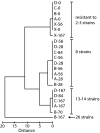Rapid diversification of coevolving marine Synechococcus and a virus
- PMID: 22388749
- PMCID: PMC3311363
- DOI: 10.1073/pnas.1120310109
Rapid diversification of coevolving marine Synechococcus and a virus
Abstract
Marine viruses impose a heavy mortality on their host bacteria, whereas at the same time the degree of viral resistance in marine bacteria appears to be high. Antagonistic coevolution--the reciprocal evolutionary change of interacting species--might reconcile these observations, if it leads to rapid and dynamic levels of viral resistance. Here we demonstrate the potential for extensive antagonistic coevolution between the ecologically important marine cyanobacterium Synechococcus and a lytic virus. In a 6-mo-long replicated chemostat experiment, Synechococcus sp. WH7803 and the virus (RIM8) underwent multiple coevolutionary cycles, leading to the rapid diversification of both host and virus. Over the course of the experiment, we detected between 4 and 13 newly evolved viral phenotypes (differing in host range) and between 4 and 11 newly evolved Synechococcus phenotypes (differing in viral resistance) in each chemostat. Genomic analysis of isolates identified several candidate genes in both the host and virus that might influence their interactions. Notably, none of the viral candidates were tail fiber genes, thought to be the primary determinants of host range in tailed bacteriophages, highlighting the difficulty in generalizing results from bacteriophage infecting γ-Proteobacteria. Finally, we show that pairwise virus-host coevolution may have broader community consequences; coevolution in the chemostat altered the sensitivity of Synechoccocus to a diverse suite of viruses, as well as the virus' ability to infect additional Synechococcus strains. Our results indicate that rapid coevolution may contribute to the generation and maintenance of Synechococcus and virus diversity and thereby influence viral-mediated mortality of these key marine bacteria.
Conflict of interest statement
The authors declare no conflict of interest.
Figures


Similar articles
-
Contrasting life strategies of viruses that infect photo- and heterotrophic bacteria, as revealed by viral tagging.mBio. 2012 Oct 30;3(6):e00373-12. doi: 10.1128/mBio.00373-12. mBio. 2012. PMID: 23111870 Free PMC article.
-
Selection and characterization of cyanophage resistance in marine Synechococcus strains.Appl Environ Microbiol. 2007 Sep;73(17):5516-22. doi: 10.1128/AEM.00356-07. Epub 2007 Jul 13. Appl Environ Microbiol. 2007. PMID: 17630310 Free PMC article.
-
Preparation of RNA from bacteria infected with bacteriophages: a case study from the marine unicellular Synechococcus sp. WH7803 infected by phage S-PM2.Methods Mol Biol. 2009;502:171-6. doi: 10.1007/978-1-60327-565-1_10. Methods Mol Biol. 2009. PMID: 19082556
-
Cyanophage infection and photoinhibition in marine cyanobacteria.Res Microbiol. 2004 Nov;155(9):720-5. doi: 10.1016/j.resmic.2004.06.002. Res Microbiol. 2004. PMID: 15501648 Review.
-
Antagonistic coevolution of marine planktonic viruses and their hosts.Ann Rev Mar Sci. 2014;6:393-414. doi: 10.1146/annurev-marine-010213-135108. Epub 2013 Aug 28. Ann Rev Mar Sci. 2014. PMID: 23987913 Review.
Cited by
-
Localized coevolution between microbial predator and prey alters community-wide gene expression and ecosystem function.ISME J. 2023 Apr;17(4):514-524. doi: 10.1038/s41396-023-01361-9. Epub 2023 Jan 19. ISME J. 2023. PMID: 36658394 Free PMC article.
-
Genetic engineering of marine cyanophages reveals integration but not lysogeny in T7-like cyanophages.ISME J. 2022 Feb;16(2):488-499. doi: 10.1038/s41396-021-01085-8. Epub 2021 Aug 24. ISME J. 2022. PMID: 34429521 Free PMC article.
-
Polyclonality of concurrent natural populations of Alteromonas macleodii.Genome Biol Evol. 2012;4(12):1360-74. doi: 10.1093/gbe/evs112. Genome Biol Evol. 2012. PMID: 23212172 Free PMC article.
-
Phage therapy: Should bacterial resistance to phages be a concern, even in the long run?Bacteriophage. 2013 Jan 1;3(1):e24219. doi: 10.4161/bact.24219. Bacteriophage. 2013. PMID: 23819105 Free PMC article.
-
Spatiotemporal Shift of T4-Like Phage Community Structure in the Three Largest Estuaries of China.Microbiol Spectr. 2023 Mar 6;11(2):e0520322. doi: 10.1128/spectrum.05203-22. Online ahead of print. Microbiol Spectr. 2023. PMID: 36877016 Free PMC article.
References
-
- Fuhrman JA. Marine viruses and their biogeochemical and ecological effects. Nature. 1999;399:541–548. - PubMed
-
- Sullivan MB, Waterbury JB, Chisholm SW. Cyanophages infecting the oceanic cyanobacterium Prochlorococcus. Nature. 2003;424:1047–1051. - PubMed
-
- Suttle CA. Marine viruses—major players in the global ecosystem. Nat Rev Microbiol. 2007;5:801–812. - PubMed
Publication types
MeSH terms
Associated data
- Actions
- Actions
- Actions
LinkOut - more resources
Full Text Sources
Molecular Biology Databases

